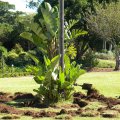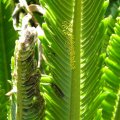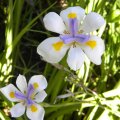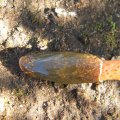Kumbula Blog
Digging out a Strelitzia
After receiving a number of enquiries with reference to removing, transplanting and sub-dividing Strelitzias, I felt I needed more information. As I had a young plant that needed removing, I grabbed my faithful gardener, Vincent, and studied the process. Despite the apparent size of the base a Stelitzia developes, it actually consists of lots of separate plants, so the process is not quite as complicated as it may seem.
Read moreCycads: Beware this pretty moth
If you are the owner of a cycad, this is the time of year to keep an eye on the young tender leaves emerging from the crown. If you are seeing damage to the leaves similar to that in the accompanying photo, read on....
Read moreColour on a winter evening
We had a lovely warm evening last night, ahead of a massive cold front and at sunset the air had a peculiarly sharp quality to it. I was wandering around the garden and realised just how much pink and mauve there is in my garden at this time of the year. I am unable to lay this out too well – waiting for my web developers to get a spare moment – so I have had to make my comments on the photos. Unfortunately my camera battery was fading and so was the light, so I blurred a couple but I...
Read moreMaking sense of botanical names of plants
Latin botanical names of plants is an area which many gardeners simply bypass as being too complicated to consider and I admit that for a long while I simply learned the names without any understanding of what they meant. But at last the lights came on and I have begun to gain some insight. So here are some basic points that helped clarify my baffled brain.
Read moreCreate a successful, low cost succulent garden
With the revival of interest in growing succulents, there has been a flurry of magazine articles, books and TV programmes about how to go about creating a succulent garden. Innovative ideas are presented and glossy pictures illustrate stunning views of pristine gardens, rich with amazing specimens, sculptures and boulders, with spaces and pathways covered with a variety of coloured stones and gravel. The optional word here being 'rich'. Little or no attention is given to the average gardener...
Read moreDog stinkhorn - Mutinus caninus
I found this stinkhorn recently in my garden. The tip is covered with slime which reportedly smells like cat faeces. The slime contains the spores. The smell attracts flies, the slime sticks to them and is then transferred to suitable places where the next fungus can grow. This fungus seems to be quite common and originates from Europe, the UK and eastern North America. They are not poisonous to humans or animals.
Read more








